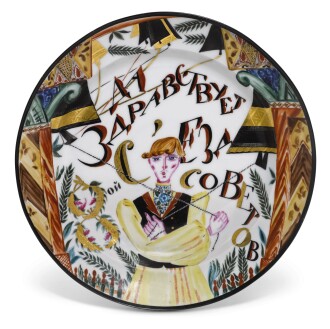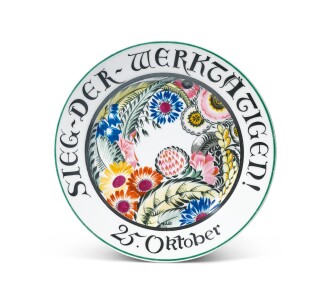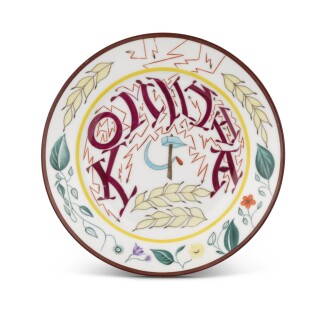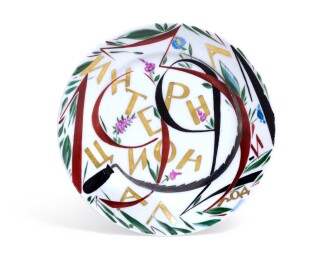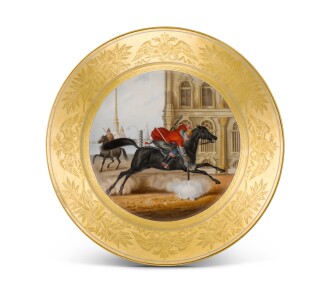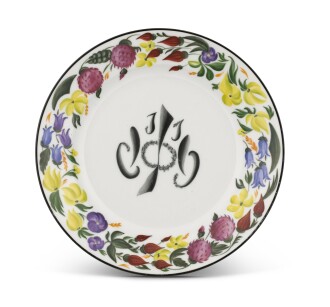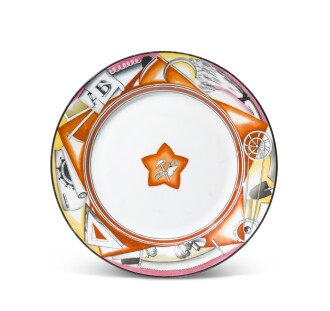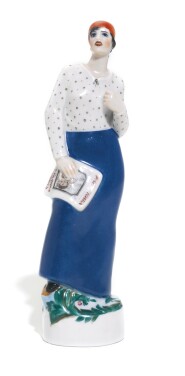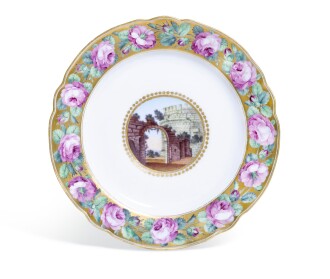-
Russian Porcelain Consignment
The link between porcelain and politics was strong as ever at the time of the Russian Revolution and the years that followed. Bolsheviks’ realised the potential of everyday objects and their ability to deliver easily accessible, yet powerful, messages to further their agenda. Thus they turned to imperial porcelain design as a quick and efficient way to influence the masses. Soon stylised revolutionary symbols with exquisite calligraphy and vivid colourful palettes found their way into porcelain works. Finally, under new leadership, artists whose names are now truly worldwide icons began to create entirely new styles and forms, expressing their utopian vision of the new era and marking a time for artistic freedom.
Sotheby’s is your most reliable resource for fine Russian, Imperial and Soviet porcelain appraisal and consignment. In June 2019, our Russian Works of Art, Fabergé and Icons sale featured the broad spectrum of traditional Russian craftsmanship. Large cloisonné enamelwork included an exceptional kovsh by the famed workshop of Feodor Rückert, and quintessentially Russian enamels were represented by craftsmen and women such as Maria Semenova and Ovchinnikov. Our porcelain section illustrated high-quality works from the Imperial Porcelain Manufactory and pieces of Soviet porcelain by artists such as Alexandra Shekatikhina-Pototskaya and Vasiliy Timorev. The sale was further highlighted by a selection of silver, icons and bronzes, including the monumental bronze of the Bogatyr Ilya Muromets by Evgeni Lanceray. When you are ready to sell an Imperial porcelain plate, Lomonosov porcelain, Russian objects of vertu, Soviet propaganda porcelain plate, Soviet figurine or Russian tea service, Sotheby’s can help you realise the highest price.
Find Out the Value of Your Russian Ceramics
Submit photos and information about your Russian ceramics to begin your complimentary estimate request.
Get an Estimate
Russian Ceramics Consigned with Sotheby's
Get Started with a Russian Porcelain Estimate
Get Started with a Russian Porcelain Estimate
Get an Estimate

Frequently Asked Questions
- When is the best time to sell my Soviet porcelain?Throughout the year, Sotheby's Decorative Arts sales attract porcelain, china and ceramics collectors from New York. London, Paris and around the world. When you are ready to sell Russian porcelain, there is no better time to consign with Sotheby’s to realise the highest price for your fine Soviet porcelain plate, platter, tea service, figurine or silver vertu object.
- Why is Russian Imperial porcelain highly collectible?Connoisseurs and enthusiasts buy and sell antique Imperial porcelain for its rarity and beauty. Sotheby’s Decorative Arts sales feature Soviet objects that were once part of distinguished royal family collections. If you wish to buy Soviet porcelain or start a collection, carefully study the overall quality of any hand painting, glazing and gilding, as well as the size and shape of the piece. Many copies exist, so be sure to inspect any numbers or marking located on the base of your plate, platter, vase or other type of Soviet porcelain.
- What types of Russian porcelain does Sotheby’s sell?Soviet porcelain figures by State Porcelain Factory artists Natalia Danko and Elena Danko, as well as Dynamo Moscow and Spartak Moscow, are highly collectible, as are propaganda plates and other collectible Soviet porcelain pieces by celebrated artists Mikhail Adamovich, Rudolf Vilde and Alexandra Shchekotikhina-Pototskaya. Useful, everyday tea sets and dinner service sets painted by artists such as Sergei Chekhonin also are coveted.
More information on how to sell with Sotheby's
Sotheby’s is your best resource to buy, consign and sell Russian porcelain, Russian china, Russian ceramics, Russian silver, Russian vertu, a porcelain plate from Russia, a Lomonosov china cup, saucer, porcelain teacups, Lomonosov teapot, a Soviet tea service, platter, figurine, tureen, salt throne, box, kovsh, goblet, cup, silver decanter, serving dishes from the Kremlin service, a Soviet vase, gilt-bronze vase, snuff box, dessert plate, dish, bowl, coffee pot, a coffee service from Moscow, scent bottle, ice pail, mug or basin. Particularly desirable are objects from the Lomonosov Porcelain Factory in Leningrad, State Porcelain Manufactory in Petrograd, Imperial Porcelain Manufactory in St Petersburg and porcelain from the periods of Alexander III, Nicholas I and Nicholas II.

